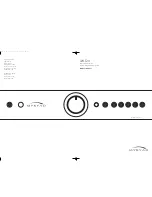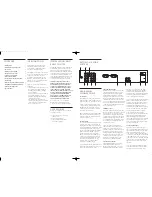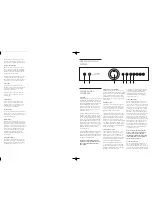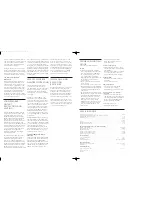
7
6
trouble-shooting
guide
some of the most common problems
No sound:
•Power turned off or system in standby
mode. Check that the green pointer LED in
the volume control knob is illuminated.
• An inoperative input has been selected
(e.g. CD input with no CD playing or
TUNER input with the tuner switched off).
• An input has been selected with no
source connected.
• TAPE 1 or TAPE 2 has been selected with
no tape playing.
• Protection relay has operated because of a
short circuit loudspeaker wire or amplifier
overheating. Carefully check all wiring after
switching the amplifier POWER OFF to
allow it to cool.
• The fuse in the power cord inlet has failed.
Unplug the power cord from both the wall
socket and the amplifier and pull out the
small receptacle below the power cord
inlet. Two fuses should be visible. The
further fuse is the operative one and
should be checked. If it has failed, replace
it with the nearer (spare) fuse. If this too
fails, then return the amplifier to your
dealer for service.
• UK version only: The fuse in the
mains plug has failed. Check and
replace if necessary.
Sound in one channel only:
• Loudspeaker cable pulled loose. Check
all connections, both at the loudspeakers
and amplifier.
• Interconnect cable pulled loose or making
poor contact. Check and, if necessary,
un-plug and re-plug all relevant cables.
Loud buzz or hum:
• Interconnect cable pulled partially out
of its socket.
• Defective interconnect cable.
Hum in tape playback:
• Tape deck too close to the amplifier
(e.g. directly above or below).
• Plugs making poor contact with sockets.
Incorrect operation – some functions
not working:
• Control processor latched. Switch of
POWER switch on rear panel and wait for
at least one minute. Then switch POWER
switch on and press STANDBY button.
Normal operation should resume.
For further help please visit
www.myryad.co.uk/faqs.html
specifications
Continuous rated power output .….….….….….….….….….….….….….….….….….….….….….….….….….….….….….….….….…8Ω:60W
(Min. power per channel, 20Hz – 20kHz, both channels, <0.05% THD)
Rated distortion (THD 20Hz – 20kHz).….….….….….….….….….….….….….….….….….….….….….….….….….….….….….…<0.05%
IHF dynamic power .….….….….….….….….….….….….….….….….….….….….….….….….….….….….….….….….….….….….….….…8Ω:80
.….….….….….….….….….….….….….….….….….….….….….….….….….….….….….….….….….….….….….….….….….….….….….…4Ω:120W
.….….….….….….….….….….….….….….….….….….….….….….….….….….….….….….….….….….….….….….….….….….….….….…2Ω:160W
Slew rate .….….….….….….….….….….….….….….….….….….….….….….….….….….….….….….….….….….….….….….….….….…>60V/µsec
Damping factor (ref. 8Ω, 50Hz) .….….….….….….….….….….….….….….….….….….….….….….….….….….….….….….….….….…>100
THD, SMPTE I.M. and IHF I.M..….….….….….….….….….….….….….….….….….….….….….….….….….….….….….….….….….…<0.05%
Line Level Inputs (Tape
1
, Tape
2
, CD, Video, Tuner, AUX)
Input impedance (R and C) .….….….….….….….….….….….….….….….….….….….….….….….….….….….….….….….….…10kΩ/420pF
Input sensitivity (ref. 60 watts).….….….….….….….….….….….….….….….….….….….….….….….….….….….….….….….….….…250mV
Maximum input signal .….….….….….….….….….….….….….….….….….….….….….….….….….….….….….….….….….….….….….…>10V
Signal/Noise ratio A-weighted (ref. 60W) .….….….….….….….….….….….….….….….….….….….….….….….….….….….….…>104dB
Signal/Noise ratio A-weighted (ref. 1W) .….….….….….….….….….….….….….….….….….….….….….….….….….….….….….…>86dB
Frequency response (20Hz – 20kHz) .….….….….….….….….….….….….….….….….….….….….….….….….….….….….….…+0/-0.3dB
Line Level Outputs
Bi-amp output impedance.….….….….….….….….….….….….….….….….….….….….….….….….….….….….….….….….….….….…450Ω
Output level .….….….….….….….….….….….….….….….….….….….….….….….….….….….….….….….….….….….….….….….….…775mV
Tape output impedance .….….….….….….….….….….….….….….….….….….….….….….….….….….….….…2kΩ + source impedance
Physical Specification
Dimensions (width x height x depth) .….….….….….….….….….….….….….….….….….….….….….….….….….…436 x 95 x 303mm
Weight, Net .….….….….….….….….….….….….….….….….….….….….….….….….….….….….….….….….….….….….….….….….….…8.75kg
Power requirements
Voltage (set by internal wiring).….….….….….….….….….….….….….….….….….….….….….….….….….….….….….….….…120/230V
Stock No: OST 0011270
Revision A
tape to be copied from a playback tape deck
connected to TAPE 2 to a recording tape deck
connected to TAPE 1. The blue LED in the
centre of the TAPE 2 button illuminates to
indicate that TAPE 2 is engaged.
Pressing the TAPE 2 button disconnects all
signals from the TAPE 2 REC output sockets.
It is therefore not possible to make a recording
onto a tape deck connected to the TAPE 2
sockets when the TAPE 2 button is engaged.
7
CD, Video, Tuner and AUX.
input selects
When you press one of these buttons you
can hear the output signal from the source
connected to respective input sockets on the
rear panel. The same signal will also be fed
to the TAPE 1 REC and TAPE 2 REC output
sockets for recording. The green LED in the
centre of the chosen button illuminates to
indicate which source has been selected.
Pressing any one of these buttons, or TAPE 2,
will disengage whichever input was previously
selected and extinguish its LED.
loudspeaker
output
protection and
muting
When the amplifier is in standby mode all
the input connectors and the loudspeaker
output terminals are isolated from the
amplifier by high quality relays. When the
amplifier is first switched on from standby
mode the loudspeaker outputs remain
disconnected for a few seconds to allow the
internal voltage levels to settle. The same
process occurs when the amplifier is switched
back into standby mode. This power-on mute
does not disconnect the headphone socket,
so it is recommended that headphones are
unplugged from the amplifier before
switching to standby mode and plugged
in again after switch-on.
The same loudspeaker mute relay is used
to protect both the amplifier and your
loudspeakers against possible damage.
If any one of a number of fault modes is
detected (loudspeaker outputs short circuit,
amplifier overheating, amplifier DC fault) the
loudspeakers will be disconnected from the
amplifier to protect both. In the case of a
short circuit or DC fault the loudspeakers will
be re-connected after a few seconds, but will
be disconnected again if the fault persists. If
overheating has caused the protection system
to operate, then it will take some time for
the heatsinks to cool sufficiently to allow the
loudspeakers to be re-connected (probably
between five and fifteen minutes depending
upon the room temperature and ventilation).
The amplifier will cool more quickly if it is
switched to standby mode, or if the POWER
is switched OFF.
remote control
handset operation
The nine keys at the top of the handset
operate the MI 120. The first six keys
(CD, TUNER, AUX, TV, TAPE 1 and TAPE 2)
function in exactly the same way as their
counterparts on the front panel, allowing
any input source to be selected for listening
or recording.
Pressing one of the VOLUME
5
or
6
buttons will cause the motorised volume
control in the amplifier to rotate clockwise
or anti-clockwise respectively. There is one
aspect in which the remote operation of the
volume control is different from manual
operation. If the amplifier is in mute mode
(after pressing MUTE on the R/C handset)
then pressing the VOLUME
5
button will
automatically disengage mute mode and
re-connect the loudspeakers. This prevents
an excessively high volume level from being
set by mistake.
Pressing the MUTE button on the handset
will engage mute mode. The loudspeakers
will be disconnected and the blue LED in the
volume control knob will flash slowly. MUTE
is a “toggle” function, so pressing the button
again will disengage the mute mode.
The green STANDBY button at the bottom
left of the handset can be used to toggle the
MI 120 into STANDBY mode (see page 5,
Front Panel Controls, section 1).
Operation of Myryad CD Players
and Tuners
The Myryad System Remote handset will also
control Myryad CD Players and Tuners. The
PLAY, PAUSE, STOP, SHUFFLE, TIME,
REPEAT, SKIP
4
and SKIP
3
keys are for CD
Player operation only. The PRESET, MANUAL,
SEARCH, MONO, STORE, TUNE
5
and
TUNE
6
are for Tuner operation only.
The remaining keys, the digits 0 to 9 and
DIM, can operate either a CD Player or a
Tuner. To control a CD Player, press the CD
input source select button. Then “0-9” and
DIM will control only the CD Player until the
TUNER input source select button is pressed.
To control a Tuner, press the TUNER input
source select button. Then “0-9” and DIM
will control only the Tuner until the CD
input source select button is pressed.
installing and
replacing
batteries
The remote handset uses four 1.5V type AAA
batteries. To fit new batteries first open
the battery compartment in the rear of the
handset and remove any existing batteries.
Fit the new ones as directed by the symbols
moulded inside the battery compartment,
then replace the battery compartment cover.
The batteries should always be removed if
they are flat (indicated by no remote control
operation or by operation only at very short
range), or if the remote control is not going
to be used for an extended period.
English MI 120 ok 29/1/01 10:17 am Page 6






















